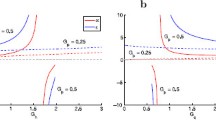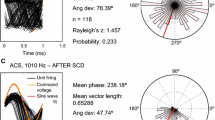Abstract
The nonlinear properties of the dendrites of the prepositus hypoglossi nucleus (PHN) neurons are essential for the operation of the vestibular neural integrator that converts a head velocity signal to one that controls eye position. A novel system of frequency probing, namely quadratic sinusoidal analysis (QSA), was used to decode the intrinsic nonlinear behavior of these neurons under voltage clamp conditions. Voltage clamp currents were measured at harmonic and interactive frequencies using specific nonoverlapping stimulation frequencies. Eigenanalysis of the QSA matrix reduces it to a remarkably compact processing unit, composed of just one or two dominant components (eigenvalues). The QSA matrix of rat PHN neurons provides signatures of the voltage dependent conductances for their particular dendritic and somatic distributions. An important part of the nonlinear response is due to the persistent sodium conductance (gNaP), which is likely to be essential for sustained effects needed for a neural integrator. It was found that responses in the range of 10 mV peak to peak could be well described by quadratic nonlinearities suggesting that effects of higher degree nonlinearities would add only marginal improvement. Therefore, the quadratic response is likely to sufficiently capture most of the nonlinear behavior of neuronal systems except for extremely large synaptic inputs. Thus, neurons have two distinct linear and quadratic functions, which shows that piecewise linear + quadratic analysis is much more complete than just piecewise linear analysis; in addition quadratic analysis can be done at a single holding potential. Furthermore, the nonlinear neuronal responses contain more frequencies over a wider frequency band than the input signal. As a consequence, they convert limited amplitude and bandwidth input signals to wider bandwidth and more complex output responses. Finally, simulations at subthreshold membrane potentials with realistic PHN neuron models suggest that the quadratic functions are fundamentally dominated by active dendritic structures and persistent sodium conductances.






Similar content being viewed by others
References
Aksay, E., Olasagasti, I., Mensh, B. D., Baker, R., Goldman, M. S., & Tank, D. W. (2007). Functional dissection of circuitry in a neural integrator. Nature Neuroscience, 10, 494–504.
Boyd, S., Tang, Y., & Chua, L. (1983). Measuring Volterra kernels. IEEE Transaction on Circuits and Systems, 30, 571–577.
Erchova, I., Kreck, G., Heinemann, U., & Herz, A. V. M. (2004). Dynamics of rat entorhinal cortex layer II and III cells: characteristics of membrane potential resonance at rest predict oscillation properties near threshold. Journal of Physiology (London), 560, 89–110.
Fishman, H. M., Poussart, D. J., Moore, L. E., & Siebenga, E. (1977). K+ conduction description from the low frequency impedance and admittance of squid axon. Journal of Membrane Biology, 32, 255–290.
FitzHugh, R. (1983). Sinusoidal voltage clamp of the Hodgkin-Huxley model. Biophysical Journal, 42, 11–16.
French, A. S. (1976). Practical nonlinear system analysis by Wiener kernel estimation in the frequency domain. Biological Cybernetics, 24, 111–119.
Goldman, M. S., Levine, J. H., Major, G., Tank, D. W., & Seung, H. S. (2003). Robust persistent neural activity in a model integrator with multiple hysteretic dendrites per neuron. Cerebral Cortex, 13, 1185–1195.
Gutkin, B. S., & Ermentrout, G. B. (1998). Dynamics of membrane excitability determine interspike interval variability: a link between spike generation mechanisms and cortical spike train statistics. Neural Computation, 10, 1047–1065.
Haas, J. S., Dorval, A. D., 2nd, & White, J. A. (2007). Contributions of Ih to feature selectivity in layer II stellate cells of the entorhinal cortex. Journal of Computational Neuroscience, 22, 161–171.
Idoux, E., Serafin, M., Fort, P., Vidal, P.-P., Beraneck, M., Vibert, N., et al. (2006). Oscillatory and intrinsic membrane properties of guinea pig nucleus prepositus hypoglossi neurons in vitro. Journal of Neurophysiology, 96, 175–196.
Idoux, E., Eugène, D., Chambaz, A., Magnani, C., White, J. A., & Moore, L. E. (2008). Control of neuronal persistent activity by voltage-dependent dendritic properties. Journal of Neurophysiology, 100, 1278–1286.
Izhikevich, E. M. (2002). Resonance and selective communication via bursts in neurons having subthreshold oscillations. BioSystems, 67, 95–102.
Johnston, D., & Narayanan, R. (2008). Active dendrites: colorful wings of the mysterious butterflies. Trends in Neurosciences, 31, 309–316.
Koulakov, A. A., Raghavachari, S., Kepecs, A., & Lisman, J. E. (2002). Model for a robust neural integrator. Nature Neuroscience, 5, 775–782.
Lewis, E. R., Henry, K. R., & Yamada, W. M. (2002). Tuning and timing of excitation and inhibition in primary auditory nerve fibers. Hearing Research, 171, 13–31.
Magnani, C., & Moore, L. E. (2011). Quadratic sinusoidal analysis of voltage clamped neurons. Journal of Computational Neuroscience, 31, 595–607.
Marmarelis, P. Z., & Naka, K. I. (1973). Nonlinear analysis and synthesis of receptive-field responses in the catfish retina. I. Horizontal cell leads to ganglion cell chain. Journal of Neurophysiology, 36, 605–618.
Moore, L. E., Fishman, H. M., & Poussart, D. J. (1980). Small-signal analysis of K+ conduction in squid axons. Journal of Membrane Biology, 54, 157–164.
Moore, L. E., Chub, N., Tabak, J., & O’Donovan, M. (1999). NMDA-induced dendritic oscillations during a soma voltage clamp of chick spinal neurons. Journal of Neuroscience, 19, 8271–8280.
Murphey, C. R., Moore, L. E., & Buchanan, J. T. (1995). Quantitative analysis of electrotonic structure and membrane properties of NMDA-activated lamprey spinal neurons. Neural Computation, 7, 486–506.
Schetzen, M. (2006). The Volterra and Wiener theories of nonliner systems. [2.] reprint ed. with add. materials. Malabar Fla.: Krieger Publ.
Silver, R. A. (2010). Neuronal arithmetic. Nature Reviews Neuroscience, 11, 474–489.
Vervaeke, K., Hu, H., Graham, L. J., & Storm, J. F. (2006). Contrasting effects of the persistent Na+ current on neuronal excitability and spike timing. Neuron, 49, 257–270.
Victor, J., & Shapley, R. (1980). A method of nonlinear analysis in the frequency domain. Biophysical Journal, 29, 459–483.
Acknowledgments
We wish to thank Professor Hans Straka for helpful comments. This work was supported in part by a grant from the Neuroinformatics Interdisciplinary Program of the CNRS.
Author information
Authors and Affiliations
Corresponding author
Additional information
Action Editor: Mark Goldman
Rights and permissions
About this article
Cite this article
Magnani, C., Eugène, D., Idoux, E. et al. Vestibular integrator neurons have quadratic functions due to voltage dependent conductances. J Comput Neurosci 35, 243–259 (2013). https://doi.org/10.1007/s10827-013-0451-y
Received:
Revised:
Accepted:
Published:
Issue Date:
DOI: https://doi.org/10.1007/s10827-013-0451-y




